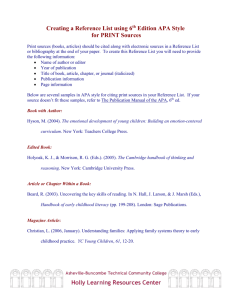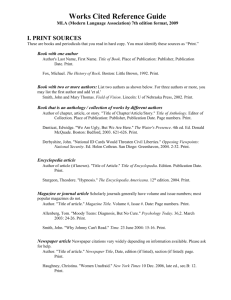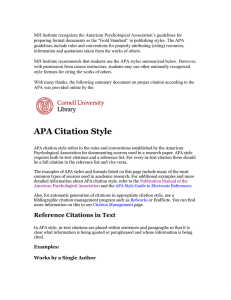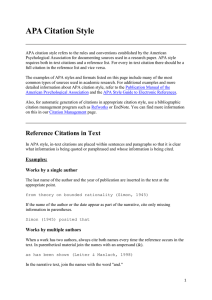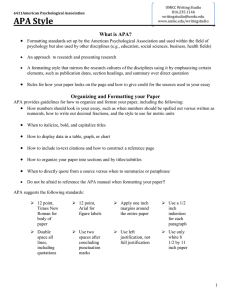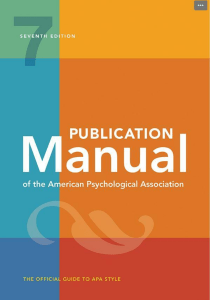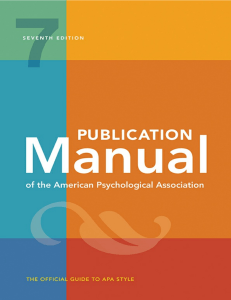Citing Print Sources (APA)
advertisement
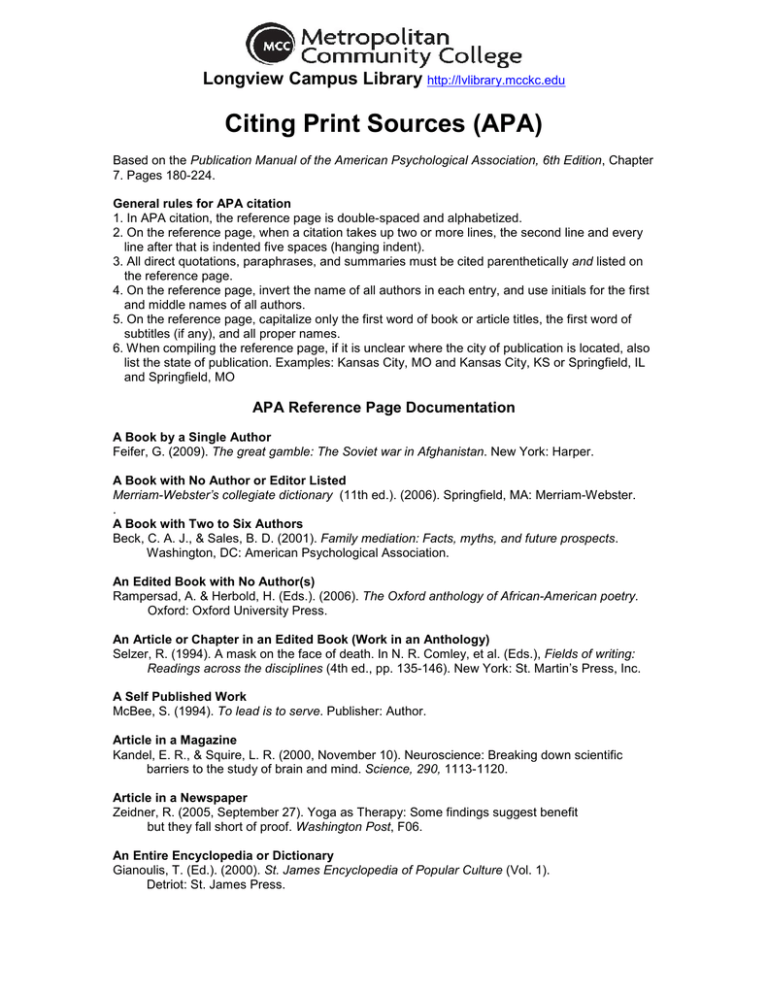
Longview Campus Library http://lvlibrary.mcckc.edu Citing Print Sources (APA) Based on the Publication Manual of the American Psychological Association, 6th Edition, Chapter 7. Pages 180-224. General rules for APA citation 1. In APA citation, the reference page is double-spaced and alphabetized. 2. On the reference page, when a citation takes up two or more lines, the second line and every line after that is indented five spaces (hanging indent). 3. All direct quotations, paraphrases, and summaries must be cited parenthetically and listed on the reference page. 4. On the reference page, invert the name of all authors in each entry, and use initials for the first and middle names of all authors. 5. On the reference page, capitalize only the first word of book or article titles, the first word of subtitles (if any), and all proper names. 6. When compiling the reference page, if it is unclear where the city of publication is located, also list the state of publication. Examples: Kansas City, MO and Kansas City, KS or Springfield, IL and Springfield, MO APA Reference Page Documentation A Book by a Single Author Feifer, G. (2009). The great gamble: The Soviet war in Afghanistan. New York: Harper. A Book with No Author or Editor Listed Merriam-Webster’s collegiate dictionary (11th ed.). (2006). Springfield, MA: Merriam-Webster. . A Book with Two to Six Authors Beck, C. A. J., & Sales, B. D. (2001). Family mediation: Facts, myths, and future prospects. Washington, DC: American Psychological Association. An Edited Book with No Author(s) Rampersad, A. & Herbold, H. (Eds.). (2006). The Oxford anthology of African-American poetry. Oxford: Oxford University Press. An Article or Chapter in an Edited Book (Work in an Anthology) Selzer, R. (1994). A mask on the face of death. In N. R. Comley, et al. (Eds.), Fields of writing: Readings across the disciplines (4th ed., pp. 135-146). New York: St. Martin’s Press, Inc. A Self Published Work McBee, S. (1994). To lead is to serve. Publisher: Author. Article in a Magazine Kandel, E. R., & Squire, L. R. (2000, November 10). Neuroscience: Breaking down scientific barriers to the study of brain and mind. Science, 290, 1113-1120. Article in a Newspaper Zeidner, R. (2005, September 27). Yoga as Therapy: Some findings suggest benefit but they fall short of proof. Washington Post, F06. An Entire Encyclopedia or Dictionary Gianoulis, T. (Ed.). (2000). St. James Encyclopedia of Popular Culture (Vol. 1). Detriot: St. James Press. An Entry in an Encyclopedia or Dictionary Bergmann, P. G. (2005). Relativity. In The new encyclopaedia Britannica (Vol. 26, pp. 501-508). Chicago: Encyclopaedia Britannica. Journal Article Mellers, B. A. (2000). Choice and the relative pleasure of consequences. Psychology Bulletin, 126, 910-924. Journal Article with Two to Six Authors Saywitz, K. J., Mannarino, A. P., Berliner, L., & Cohen, J. A. (2000). Treatment for sexually abused children and adolescents. American Psychologist, 55, 1040-1049. A Publication with More than Six Authors or Editors Note that this format works for all types of print sources with more than six authors: Xin Shen, Gui-bin Hu, Si-jing Jiang, Feng-rong He, Wei Xing, Li Li, …Guan-xin Shen (2009). Engineering and characterization of a baculovirus-expressed mouse/human chimeric antibody against transferrin receptor. Protein Engineering and Design and Selection, 22, 723-731. Brochure (Treat a brochure as you would a book. The only addition is to identify the publication as a brochure.) Research and Training Center on Independent Living. (1993). Guidelines for reporting and writing about people with disabilities (4th ed.) [Brochure]. Lawrence, KS: Author. Book Review Mroczek, D. K. (2000). The emerging study of midlife [Review of the book Life in the middle: Psychological and social development in middle age]. Contemporary Psychology: APA Review of Books, 45, 482-485. Motion Picture Zaentz, S., & Douglas, M. (Producers), & Forman, M. (Director). (1975). One flew over the cuckoo’s nest [Motion Picture]. United States: Fantasy Films. Personal Communications Personal Communications may be letters, memos, e-mails, personal interviews, telephone conversations, and the like. Because they do not provide recoverable data, personal communications are not included in the reference list. Cite personal communications in-text only. D. Sager (personal communication, November 23, 2002). B. Foster, (personal communication, September 12, 2009). Ref_Lib/Handouts 03-10

